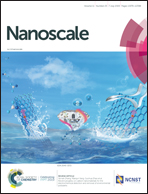Single-molecule force spectroscopy to decipher the early signalling step in membrane-bound penicillin receptors embedded into a lipid bilayer†
Abstract
Understanding the molecular mechanism by which the signal of the presence of an antibiotic is transduced from outside to inside the bacterial cell is of fundamental interest for the β-lactam antibiotic resistance problem, but remains difficult to accomplish. No approach has ever addressed entire penicillin receptors in a membrane environment. Here we describe a method to investigate the purified Bacillus licheniformis BlaR1 receptor –a membrane-bound penicillin receptor involved in β-lactam resistance– embedded into a lipid bilayer in absence or presence of penicillin. By selecting a mutated receptor blocked in its signal transduction pathway just after its activation by penicillin, we revealed the very first step of receptor signalling by unfolding the receptor from its C-terminal end by AFM-based single-molecule force spectroscopy. We showed that the presence of the antibiotic entails significant conformational changes within the receptor. Our approach opens an avenue to study signal-transduction pathways mediated by membrane-bound proteins in a membrane environment.



 Please wait while we load your content...
Please wait while we load your content...